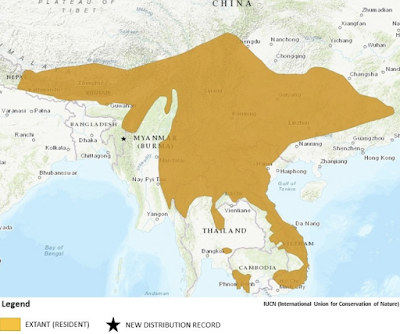The Spotted Linsang, Prionodon pardicolor, is a small, nocturnal, tree-dwelling Carnivoran Mammal found across much of Southeast Asia and neighbouring areas. Together with the Banded Linsang, Prionodon linsang, it makes up the Family Prionodontidae, which has recently been shown to be the sister group to the Felids (African Linsangs, Poiana spp., are more closely related to Civits). The Spotted Linsang is known from Assam, Mizoram, Manipor, Nagaland, Sikkim, Arunachal Pradesh, and Meghalaya states in India, as well as eastern Nepal, northeastern India, Bhutan, northern & central Myanmar, northern and central Thailand, Laos, Cambodia, most of Vietnam, and central to southern China. Because of its wide geographical distribution, it is considered to be of Least Concern under the terms of the International Union for the Conservation of Nature's Red List of Threatened Species, but because of its secretive nature, it is far from clear how abundant this species actually is, nor whether it is threatened by the widespread Human encroachment into forest habitats across much of its range.
In a paper published in the Journal of Threatened Taxa on 26 November 2022, Amit Kumar Bal of the Society for the Preservation of Endangered Carnivores and their International Ecological Study, and the Amity Institute of Forestry and Wildlife at Amity University, and Anthorny Giordano, also of the Society for the Preservation of Endangered Carnivores and their International Ecological Study, present the first evidence for the presence of the Spotted Linsang within the Murlen National Park in southern Mizoram State, a significant increase in the species known range, and discus the potential impact of Human-Linsang interactions upon the future of the species.
The Murlen National Park lies within the Champhai District of Mizoram, and forms part of the Indo-Burman Biodiversity Hotspot. The park covers a range of hilly and mountainous terrains, and includes areas of tropical and subtropical forests. While in theory protected, wildlife in the park is threatened by a number of Human activities, including logging, hunting, Cattle grazing, and the Jhum cultivation (a form of slash-and-burn agriculture).
Bal and Giordano deployed 10 camera traps within the park between November 2019 and May 2022, as part of a wider study into small carnivore populations, and the threats that they face. During this time (over 400 nights of observation), Bal and Giordano captured six images of Spotted Linsangs, an Animal not previously thought to be present within the park.
During the course of the study, Bal and Giordano also observed the carcass of a Spotted Linsang within the home of a hunter in Murlen. When questioned on the subject, the hunter admitted to having shot the Animal with a hand-held catapult, in the belief that it was a Leopard Cat, several body parts of which can be traded locally. The hunter stated that he did not know what the Spotted Linsang was, and that he had never seen such an Animal before. This specimen was 69 cm in length, 35 cm of which was made up by the tail.
Camera trap observations, or observations of any kind, are rare for Spotted Linsangs, which makes estimations of their population difficult. This presumably also makes them less prone to being targeted by Human hunters, although they are clearly not immune from this threat. Dead Spotted Linsangs have also been observed by Amit Kumar Bal caught in snare traps in Arunachal Pradesh, a more indiscriminate form of hunting widely practised in India and Southeast Asia. There are also reports of their having been killed for their skins in Arunachal Pradesh, as well as in retribution for their hunting of domestic poultry. Bal and Giordano suggest that the species should be subject to a more detailed study, covering a wider geographical area, to better understand its population structure and the threats it faces from Human encroachments.
See also...
Follow Sciency Thoughts on Facebook.
Follow Sciency Thoughts on Twitter.









